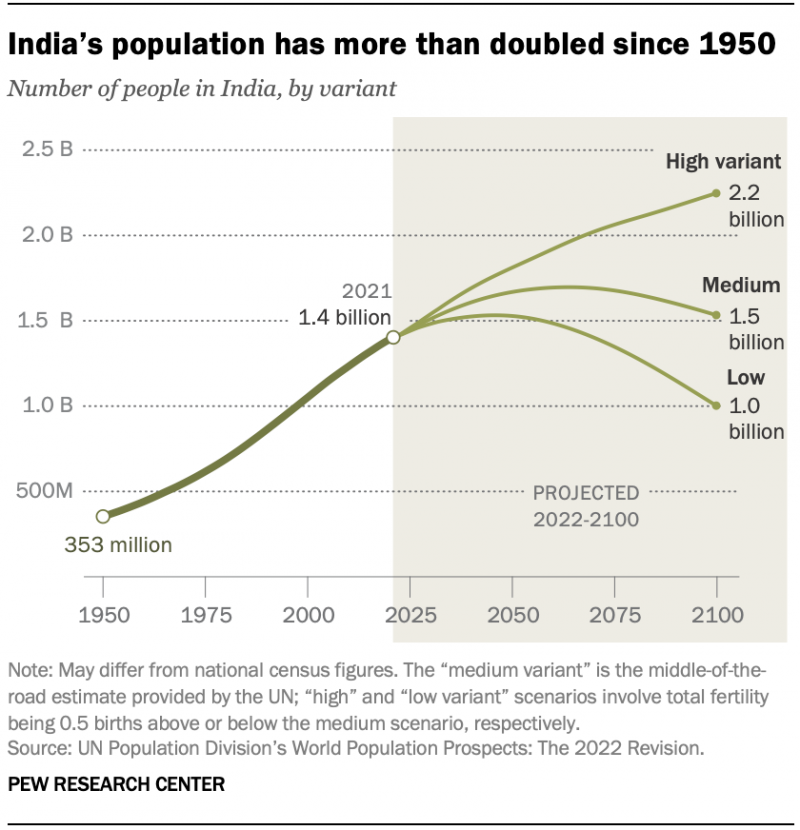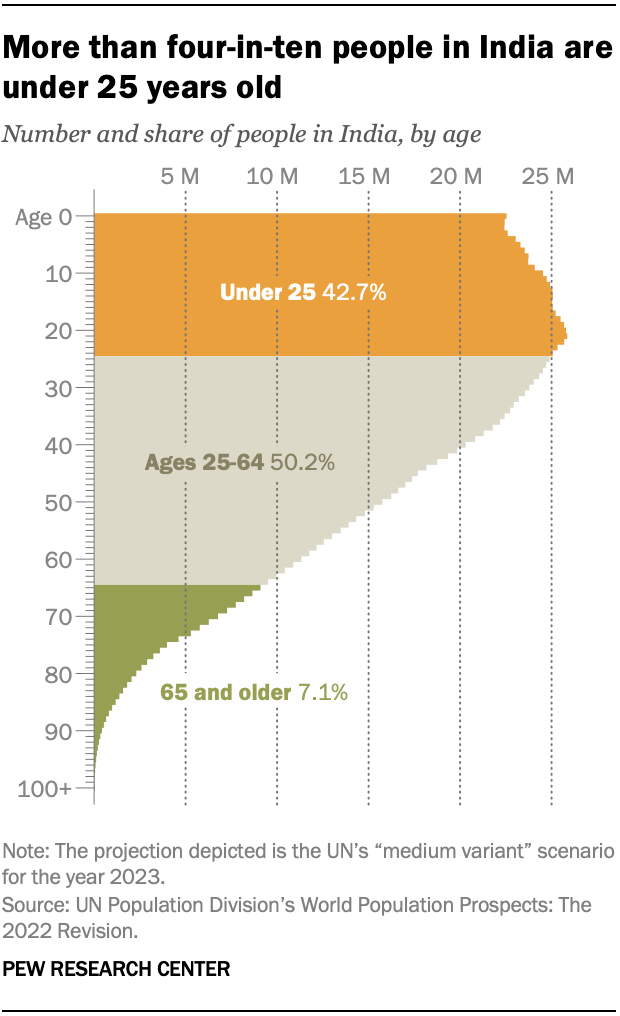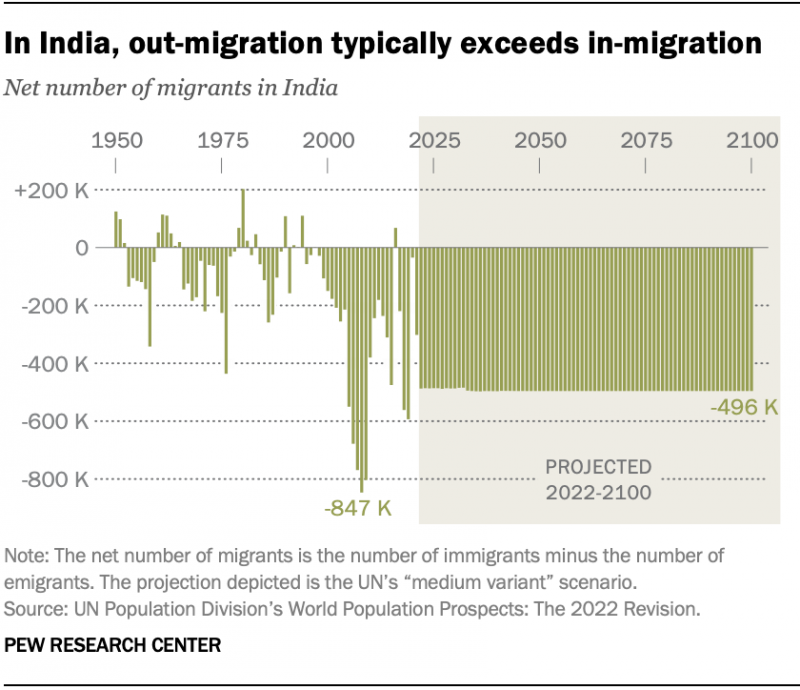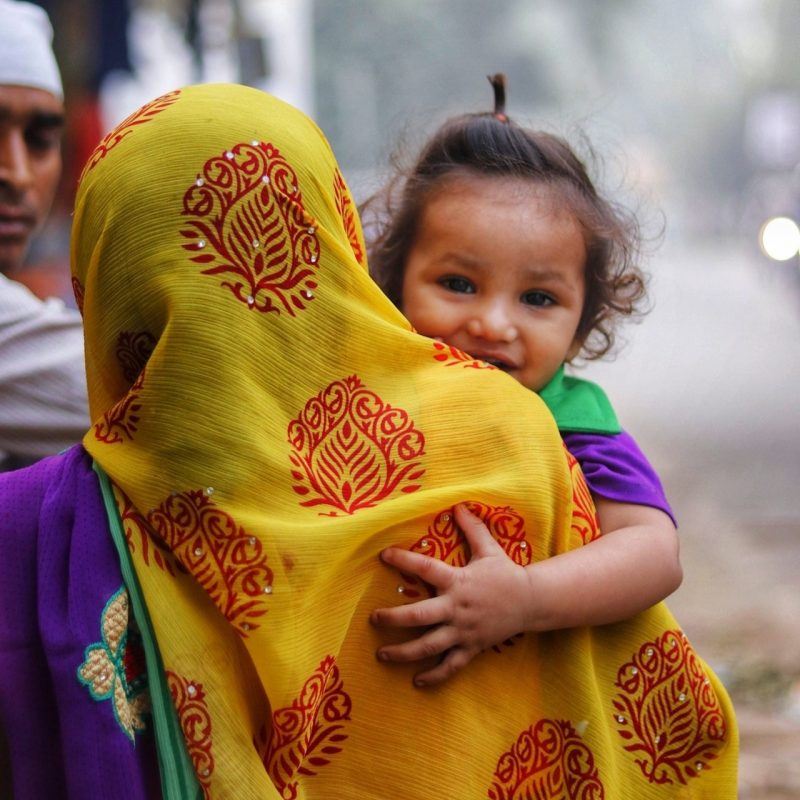
India to replace China as most populous country
The Associated Press reported this morning that India will likely overtake China in population sometime this month (April 2023), making India the world’s most populous country. Or, if not in April 2023, then a few months from now.
Or maybe it’s already happened.
Though of course it’s not possible to know an exact date, the most likely estimates from demographers at the United Nations and elsewhere point to the middle of April 2023.
China has been the world’s most populous country since at least 1950, according to the UN and the Pew Research Center. India and China are now running neck-in-neck in population, with each having a population of around 1.4 billion people. Together, their peoples comprise more than 1/3 of Earth’s current population of 8 billion.

India is a youthful population
When the United Nations began keeping its population figures in 1950, India had a billion fewer people than it does now.
And no one knows exactly how many people India has today; it hasn’t conducted a census since 2011.
But estimates from demographers put both India’s and China’s population at around 1.4 billion. And India’s population is growing, while China’s is declining. A declining population may also be also a graying population.
And the reverse can also be true. A population increase can mean more young people in a given population. That’s the case in India today. According to Pew Research, more than 40% of India’s population is under the age of 25. It is a very young country.
In fact, globally, one-in-five people who are under the age of 25 live in India.
Meanwhile, the next two most populous countries – China and the United States – have populations that are rapidly aging. People aged 65 and older make up 18% of the U.S. population and 14% of China’s population.
For India, that number of people 65 and older is just 7%.

India’s limiting factors
On the other hand, India’s fertility rate is decreasing from what it was in the early part of the 20th century. In 1950, the average Indian woman had 5.9 children. And, in 1992, the average Indian woman had 3.4 children.
Today, the number is down to 2.0 children. But that number is still higher than in China (1.2) and the U.S. (1.6).
And here’s another factor that keeps India’s population from being higher than it is now: more people move out of India each year than move in. For example, India lost about 300,000 people due to migration in 2021.


Bottom line: India is overtaking China as the world’s most populous country. Both currently have around 1.4 billion people. India may take the title sometime in April 2023.
The post Most populous country? India (probably) as of April 2023 first appeared on EarthSky.
from EarthSky https://ift.tt/xl4eq9I

India to replace China as most populous country
The Associated Press reported this morning that India will likely overtake China in population sometime this month (April 2023), making India the world’s most populous country. Or, if not in April 2023, then a few months from now.
Or maybe it’s already happened.
Though of course it’s not possible to know an exact date, the most likely estimates from demographers at the United Nations and elsewhere point to the middle of April 2023.
China has been the world’s most populous country since at least 1950, according to the UN and the Pew Research Center. India and China are now running neck-in-neck in population, with each having a population of around 1.4 billion people. Together, their peoples comprise more than 1/3 of Earth’s current population of 8 billion.

India is a youthful population
When the United Nations began keeping its population figures in 1950, India had a billion fewer people than it does now.
And no one knows exactly how many people India has today; it hasn’t conducted a census since 2011.
But estimates from demographers put both India’s and China’s population at around 1.4 billion. And India’s population is growing, while China’s is declining. A declining population may also be also a graying population.
And the reverse can also be true. A population increase can mean more young people in a given population. That’s the case in India today. According to Pew Research, more than 40% of India’s population is under the age of 25. It is a very young country.
In fact, globally, one-in-five people who are under the age of 25 live in India.
Meanwhile, the next two most populous countries – China and the United States – have populations that are rapidly aging. People aged 65 and older make up 18% of the U.S. population and 14% of China’s population.
For India, that number of people 65 and older is just 7%.

India’s limiting factors
On the other hand, India’s fertility rate is decreasing from what it was in the early part of the 20th century. In 1950, the average Indian woman had 5.9 children. And, in 1992, the average Indian woman had 3.4 children.
Today, the number is down to 2.0 children. But that number is still higher than in China (1.2) and the U.S. (1.6).
And here’s another factor that keeps India’s population from being higher than it is now: more people move out of India each year than move in. For example, India lost about 300,000 people due to migration in 2021.


Bottom line: India is overtaking China as the world’s most populous country. Both currently have around 1.4 billion people. India may take the title sometime in April 2023.
The post Most populous country? India (probably) as of April 2023 first appeared on EarthSky.
from EarthSky https://ift.tt/xl4eq9I

Aucun commentaire:
Enregistrer un commentaire